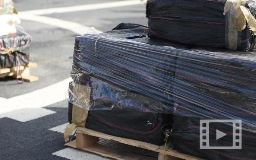IMAGERY AVAILABLE: Alameda-based Coast Guard cutter returns home following 104-day patrol, more than 16,000 pounds of cocaine seized
U.S. Coast Guard sent this bulletin at 10/04/2018 10:45 PM EDT
| News Release |
U.S. Coast Guard Pacific Area |
Alameda-based Coast Guard cutter returns home following 104-day patrol, more than 16,000 pounds of cocaine seized
 |
 |
 |
 |
 |
 |
 |
 |
Editors' Note: Click on images to download high resolution version.
ALAMEDA, Calif. – The Coast Guard Cutter Stratton returned home Thursday to Coast Guard Island following a 104-day, 23,500 nautical-mile patrol that included enforcement of fisheries regulations in Alaska and interdicting more than 16,000 pounds of cocaine from known drug trafficking zones in the Eastern Pacific Ocean.
Stratton’s crew began their deployment in the Arctic Ocean supporting Coast Guard District Seventeen and Operation Arctic Shield. Deploying with a MH-65 Dolphin helicopter and an aircrew from Air Station San Francisco, Stratton provided maritime domain awareness in waters off the north slope of Alaska, ensuring the sovereignty over U.S. waters in the region. Stratton also served as a search and rescue platform and conducted living marine resource and commercial vessel safety regulation enforcement.
U.S. waters surrounding Alaska support significant renewable resources, including a robust fishing industry. More than 59 percent of fish caught in the United States are harvested from Alaskan waters, generating more than $6.4 billion annually. The U.S. Coast Guard is responsible for conducting at-sea enforcement in direct support of both domestic and international fisheries management schemes to ensure the sustainability of these living marine resources.
Stratton additionally patrolled international waters off the coasts of Central and South America conducting counter-drug operations with an aircrew and a MH-65 Dolphin helicopter from Coast Guard Helicopter Interdiction Tactical Squadron based in Jacksonville, Florida. Stratton partnered with units from multiple U.S. agencies in support of the Eleventh Coast Guard District, headquartered in Alameda, and the Joint Interagency Task Force-South based in Key West, Florida.
The crew interdicted seven drug smuggling vessels in 26 days, including three low-profile go-fast vessels. The interdictions yielded more than 16,000 pounds of cocaine seized by Stratton’s crew worth an estimated $235 million wholesale and detained 23 suspected smugglers for prosecution in U.S. and partner nation courts.
Stratton crewmembers offloaded more than 22,000 pounds of cocaine Wednesday in San Diego. The cocaine offloaded was seized from international waters in the Eastern Pacific Ocean by Coast Guard cutters Stratton (WMSL-752), Seneca (WMEC-906) and Active (WMEC-618) from late August to mid-September.
"This offload reflects the outstanding efforts of the Coast Guard and our partner agencies to disrupt and dismantle transnational criminal organizations,” said Capt. Craig J. Wieschhorster, commanding officer of Coast Guard Cutter Stratton. “These interdiction results take hundreds of millions of dollars away from these criminal networks that work to undermine the rule of law in South and Central America which increases migration pressures on the U.S. southern border. Keeping this product off the streets of America saves lives, and I am very proud of the efforts of my crew."
Numerous U.S. agencies from the Departments of Defense, Justice and Homeland Security cooperated in the effort to combat transnational organized crime. The Coast Guard, Navy, Customs and Border Protection, FBI, Drug Enforcement Administration and Immigration and Customs Enforcement along with allied and international partner agencies play a role in counter-drug operations. The fight against transnational criminal organizations in the Eastern Pacific requires unity of effort in all phases from detection, monitoring and interdictions, to criminal prosecutions by U.S. Attorneys in districts across the nation.
The Coast Guard increased U.S. and allied presence in the Eastern Pacific Ocean and Caribbean Basin, which are known drug transit zones off of Central and South America, as part of its Western Hemisphere Strategy. During at-sea interdictions in international waters, a suspect vessel is initially detected and monitored by allied, military or law enforcement personnel coordinated by Joint Interagency Task Force-South. The law enforcement phase of counter-smuggling operations in the Eastern Pacific is conducted under the authority of the 11th Coast Guard District. The interdictions, including the actual boardings, are led and conducted by members of the U.S. Coast Guard.
Throughout the patrol, Stratton leveraged a Small Unmanned Aerial System (sUAS) for mission support in both operational theatres. The sUAS provided the crew real-time video footage through aerial surveillance and expanded Stratton’s capabilities to support operations across all Coast Guard missions. The real-time video increases situational awareness enabling the crew to make more-informed decisions and assists with mission planning, efficiency and crew safety.
Stratton is a 418-foot long National Security Cutter and one of four NSCs homeported in Alameda. NSCs are designed to patrol the open ocean and serve as a command and control center for complex law enforcement, defense and national security missions. NSCs displace 4,500 tons with a full load, have a range of 12,000 nautical miles and can endure up to 90-day patrol cycles. The cutters feature advanced command, control, communication, computers, intelligence, surveillance and reconnaissance equipment, aviation support facilities and a stern cutter boat launch.
To learn more about your United States Coast Guard, please visit: www.uscg.mil
-USCG-

